
Like most robotic combat spectators, I like watching robots with active weapons. So I assumed it would follow that I would not enjoy driving toy robots with no active weapons. As a result, I never bothered buying any of the Custom Series radio-controlled toys, since the driver cannot choose when the weapon will activate on them.
But after a lot of playing with the Pro Series, where controlling the weapons on those toys served no practical purpose (both were much more effective as simple ramming devices on wheels), I thought that maybe those Custom Series toys weren't so bad after all. And when I saw that a whole bunch of them were drastically reduced in price, I couldn't say no. Five bucks for a radio-controlled toy? The thing could've exploded two minutes after I removed it from the box and I still would've felt that I had gotten my money's worth.
So I now own five of the eight Custom Series toys. Some are better than others, and I've taken it upon myself to write about the pros and cons of each one. It's painstaking, back-breaking work, I know. But I do it out of love.
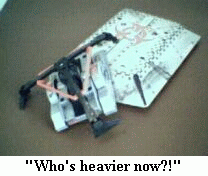 First of all, the size. Obviously, the Custom Series toys are smaller and lighter than the Pro Series toys. It's difficult to give the general dimensions of the toys, since each one is a different shape. As for weight, um... I don't have a scale on me. Well, the Custom Series toys are frequently used as the basis for antweights, while the Pro Series toy have been used as the basis for beetleweights. So there you go.
First of all, the size. Obviously, the Custom Series toys are smaller and lighter than the Pro Series toys. It's difficult to give the general dimensions of the toys, since each one is a different shape. As for weight, um... I don't have a scale on me. Well, the Custom Series toys are frequently used as the basis for antweights, while the Pro Series toy have been used as the basis for beetleweights. So there you go.
The toy line is called "Custom Series" for a couple of reasons. For one thing, "Smaller, Less Powerful Series" would've resulted in low sales. But primarily, the idea behind the series was that any toy could be customized into whatever you wanted. Provided that whatever you wanted was represented by the additional pieces of plastic that came with each toy. And to be honest, I don't think anybody has ever said, "You know what I want? A Dr. Inferno Jr. toy that has motionless halves of saw blades sticking unnaturally out of its side wedges."
I'll get into those details as I discuss each specific toy. But first, let's look at what makes these toys tick. Each and every Custom Series toy is formed around the exact same chassis. The chassis comes with a place to insert four AA batteries, some kind of motor or similar motion-creating device, and two big wheels that are controlled by the motor (one wheel on each side, obviously). Somewhere between two and four additional, smaller, free-spinning wheels are added to the chassis, around the large wheels. The wheels on the toys with treads are shaped differently, for obvious reasons.
The chassis comes with a place to insert four AA batteries, some kind of motor or similar motion-creating device, and two big wheels that are controlled by the motor (one wheel on each side, obviously). Somewhere between two and four additional, smaller, free-spinning wheels are added to the chassis, around the large wheels. The wheels on the toys with treads are shaped differently, for obvious reasons.
To make the chassis look like a specific robot, an outer shell and other pieces are added around the chassis. Since the chassis is fairly tall (and, curiously, in a shape that really doesn't approximate most robots), this means that sometimes the familiar shape of a robot has to be altered to make the shell fit over the chassis. You'll see a couple examples of that as we move along.
Along with the chassis, each toy consists primarily of the aforementioned shell and a piece that relates to weapon movement. As the motorized wheels move forward, they turn two gears located in the center of the chassis. Each of the Custom Series toys has been designed with a special piece that slides into the chassis, locks into place, and contains additional gears that control the toy's weapon motion. As you drive forward, the weapon moves. That's as close to controlling the weapon as you're going to get on these things.
Apparently, it's vitally important that a Custom Series toy have a weapon at all times. The chassis will refuse to respond to any transmitted signals unless the piece holding the weapon has been slid into place. It's an odd feature, the purpose of which I really don't understand. But really, are you going to deliberately remove the only thing that differentiates your toy from a poorly-designed pushbot?
(IMPORTANT NOTE: I am not taking sides in the pushbot vs. spinner war. After all, I've already gone on record as being a proponent of lifters. The "poorly-designed pushbot" comment above refers not to the class of pushbots, but to what the Custom Series toys would be like if they had no pretend weapons. I mean, there's a large gap between any toy's body and the floor! If you had a pushbot with that kind of design flaw, would you expect to win? Please do not ram down my door and break my ankles. Thank you.)
Just like the Pro Series, the Custom Series comes in one of two bandwidths, with four available channels on each bandwidth for the possibility of an eight-robot rumble. I suppose that if you purchased enough of the toys, since the shells can be snapped onto any chassis, you could theoretically have eight of the same robot fighting in a rumble. That could be interesting. But probably boring. Forget I even brought it up.
Also similar to the Pro Series, each Custom Series toy has an LED on top that serves to both tell you that the toy is on and register that wonderful "virtual damage." If you haven't read my discussion of the Pro Series toys (and trust me, this review would make quite a bit more sense if you did, since I'm unnaturally comparing the Custom Series to the Pro Series, even though the Custom Series was far more readily available to the public), I'll explain "virtual damage." Since the toys can't actually damage one another (would people really buy them if they broke within a week?), there are sensors inside the chassis that detect when the toy has been given a particularly strong wallop to the side. When a wallop is detected, "virtual damage" is registered. On the Custom Series, one wallop causes the LED on the robot to blink. A second wallop turns the LED, and the toy, off.
For the record, virtual damage is meaningless in the Custom Series. You simply cannot get it to register during a normal fight. The only time I've ever gotten one of those LEDs to blink is when I had the toys fight on a card table and one of them plummeted to the floor below. And since the toys themselves do not accelerate at a rate of 32 feet per second, you can safely ignore the whole concept of "virtual damage."
The controllers/transmitters for the Custom Series are a little smaller than those for the Pro Series. Of course, the toys are all driven tank-style, with one joystick controlling each wheel. Again, there are two buttons at the top of the controller, but the buttons serve different functions here, since there's no third weapon channel to control. The button on the top left, when pressed, causes the toy to drive forward in a straight line (compare this with the fact that that button is on the top right in the Pro Series, serving to confuse us all). The button on the top right will send your robot into a counterclockwise spin.
The interesting thing is, on the Custom Series, these buttons actually serve a purpose. For whatever reason, the actions performed by the buttons on the top of the controller are faster than the actions performed when you push the joysticks forward or back. With certain toys, a fast spin is a useful thing (as you'll read about). And being able to use that "forward charge" button is crucial to winning fights. When you want to push your opponent across the floor, you've got to use that button. And when you've got your opponent trapped against the wall, ram 'em by backing up a short distance with the joysticks, then quickly slamming into them with the button. Repeat as your opponent tries to escape. Frustrate your opponent and become the winner.
Just for jollies, I think I'll review the toys in ascending order of usefulness in combat. It's not a perfect ranking (you could make a strong argument against any of my choices), but it's more fun than, say, alphabetical order, isn't it? So here are the five toys I own and am gradually becoming familiar with:
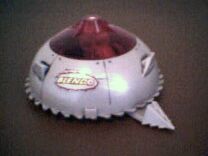
BLENDO
What? A spinner in a line of toys that, let's face it, was primarily marketed toward children? You know what that means -- the spinner cannot possibly do any form of damage, lest BattleBots, Tiger, Hasbro, Jamie Hyneman, Duracell, and possibly even the television series "C.S.I." be sued by hundreds of angry parents because their children mutilated their fingers while playing with the toy.
And that's the problem with the Blendo toy -- when you can't do any damage with it, all you have is a big, round robot. Have you ever tried to win a pushing match with a big, round robot, the shell of which slowly rotates? Here's a hint: you won't succeed.
But perhaps I'm getting ahead of myself, since my original plan was to describe the physical features of each toy, then explain how well it fights. If you remember the real Blendo from TV (and congratulations if you do, since it was never shown in a one-on-one fight), then you're probably looking at the toy and saying to yourself, "That's not Blendo! That's some kind of mechanized turtle!"
They've clearly taken some liberties with the real Blendo's shape to create this toy. But for the most part, at least those liberties were taken for specific reasons. For example, the transparent red plastic on the top of the shell. That's there so you can see the LED located on the chassis. Ah, of course.
That bizarre little arrowhead sticking out from underneath the shell also serves an actual purpose. Since Blendo's exterior is constantly moving, it's difficult to know which way is forward. The arrow points the way -- since it's attached to the chassis underneath, whichever direction it's pointing is forward. In theory, it could also serve as a kind of small wedge to get underneath opponents. In theory.
As for the saw-like edges along the lower perimeter of the shell... well, I don't know why those are there.
As you drive forward, the shell will spin. Rather slowly. Jeez, you'll never even look like you're doing damage with that. Here's what you should do while fighting as Blendo: Press your finger firmly against the "spin around quickly" button. As Blendo's body spins around rapidly, the shell will also spin in the same direction as the body, combining the velocities of the motions and (insert explanation from high school physics class here), creating a nice and fast spin. When you let go of the button, the shell will continue to spin for a short time. In that short time, ram yourself into your opponent. It won't do any kind of damage whatsoever, but it's the only offensive maneuver you have.
There's only one problem with this strategy -- if you try to drive forward into your opponent, you won't hit it with the spinning shell. Instead, that blasted arrowhead will get in the way. So you either have to back into your opponent or remove the arrowhead. Remove the arrowhead.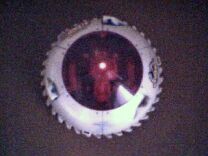 It snaps off of the chassis rather easily, and you can always snap it back on if you want to fool around with it or take a picture of it for your web site. How do you know which way is forward without the arrowhead? Just look at the LED through the red top of Blendo's shell. Drive in the direction opposite the LED to move forward (or back up, if the LED is closer to your opponent). After a little practice, you get used to it. And Blendo looks a lot cooler without that silly arrow.
It snaps off of the chassis rather easily, and you can always snap it back on if you want to fool around with it or take a picture of it for your web site. How do you know which way is forward without the arrowhead? Just look at the LED through the red top of Blendo's shell. Drive in the direction opposite the LED to move forward (or back up, if the LED is closer to your opponent). After a little practice, you get used to it. And Blendo looks a lot cooler without that silly arrow.
Each Custom Series toy comes with additional pieces that you can attach to the body. The primary purpose of these pieces -- this is the truth -- is for them to fall off during battle. I'm not kidding. The instructions even say so: "These pieces are designed to absorb impact and fly apart when the Bot is struck in combat." Which maybe would mean something if the virtual damage would ever register, but since it doesn't, the pieces are there solely so it looks like you're losing.
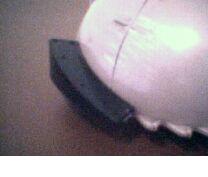 Blendo's "extra pieces" are three curved wedges that fit into slots at the bottom of the shell. They look like additional impact extrusions, like the ones farther up the shell, except they wedge upward. As far as fighting with them goes, though, I'd leave them off. Since you don't do any damage to an opponent even if you come to an abrupt stop against their armor while spinning, they serve no point. Plus, the saw-like edge makes a nifty buzzing sound against plastic that at least sounds like you could theoretically be hurting something.
Blendo's "extra pieces" are three curved wedges that fit into slots at the bottom of the shell. They look like additional impact extrusions, like the ones farther up the shell, except they wedge upward. As far as fighting with them goes, though, I'd leave them off. Since you don't do any damage to an opponent even if you come to an abrupt stop against their armor while spinning, they serve no point. Plus, the saw-like edge makes a nifty buzzing sound against plastic that at least sounds like you could theoretically be hurting something.
As we've seen so often with full-body spinners that break down in the middle of a fight, without the damage caused by the spinning, full-body spinners can't do much offensively. The Blendo toy simply will not win any fight. And it's not even much fun to beat up with most of the other toys. This is the one that gets played with the least around here.
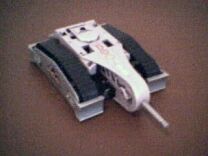
DOOALL
Continuing our theme of "robots you haven't seen fight on TV since season two of 'BattleBots,'" here's DooAll. As you can see, DooAll uses treads instead of plain ol' wheels to move around. Which gives it better traction against the floor, but, since all of the chassis (chassises?)' wheels move at the same speed, makes it slower than the other toys.
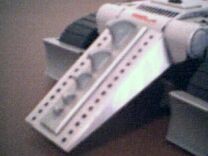 In the rear of DooAll is a wedged tail. As is the case on every single radio-controlled BattleBots toy, the wedge does not come close to reaching the ground. There is also some kind of spike attachment you can place on the tail, making DooAll look more like some kind of stegosaurus, or maybe a mutant shark. When it's not being knocked off in combat, this piece makes it more difficult for DooAll to get that wedge underneath opponents. Take it off and put it back in the box.
In the rear of DooAll is a wedged tail. As is the case on every single radio-controlled BattleBots toy, the wedge does not come close to reaching the ground. There is also some kind of spike attachment you can place on the tail, making DooAll look more like some kind of stegosaurus, or maybe a mutant shark. When it's not being knocked off in combat, this piece makes it more difficult for DooAll to get that wedge underneath opponents. Take it off and put it back in the box.
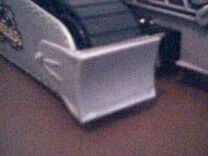 While we're on the subject of extra pieces, DooAll comes with four optional attachments that are actually based on something found on the real robot. On the real DooAll, these curved doohickeys served both as a way to push opponents around while the weapon was pointed upward, and also to keep spinners from destroying the treads. Since you won't be facing any damage-causing spinners, and since the weapon doesn't move up and down (bonus points if you remembered that DooAll's weapon could move up and down; take away those bonus points if you expected the toy to emulate that), the pieces' only purpose is to... fall off. Again, I'd recommend you remove them.
While we're on the subject of extra pieces, DooAll comes with four optional attachments that are actually based on something found on the real robot. On the real DooAll, these curved doohickeys served both as a way to push opponents around while the weapon was pointed upward, and also to keep spinners from destroying the treads. Since you won't be facing any damage-causing spinners, and since the weapon doesn't move up and down (bonus points if you remembered that DooAll's weapon could move up and down; take away those bonus points if you expected the toy to emulate that), the pieces' only purpose is to... fall off. Again, I'd recommend you remove them.
Speaking of things that fall off, those long strips of plastic on the side that are outlined by the treads are not attached with any great force. Frequently during a fight, they'll just come off with no provocation whatsoever. This is actually good for DooAll, because the wheeled robots can get high-centered on these stray pieces, while DooAll can just roll over them, thanks to the treads.
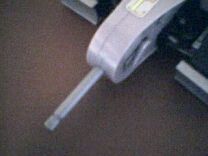 The real DooAll's weapon was a pneumatic spike, which has proven to be a very effective weapon in robot combat over the years. So you can just imagine how effective a non-life-threatening toy based on a pneumatic spike is going to be. The toy DooAll's spike is spring-loaded. As you drive forward, the spike slowly retracts into DooAll's body. Then, suddenly, the spike pops out. Actually, I can't in good conscience call that a spike. Children could put their eyes out if the toy had a spike on it. That is clearly a rod. A weapon of a spring-loaded rod.
The real DooAll's weapon was a pneumatic spike, which has proven to be a very effective weapon in robot combat over the years. So you can just imagine how effective a non-life-threatening toy based on a pneumatic spike is going to be. The toy DooAll's spike is spring-loaded. As you drive forward, the spike slowly retracts into DooAll's body. Then, suddenly, the spike pops out. Actually, I can't in good conscience call that a spike. Children could put their eyes out if the toy had a spike on it. That is clearly a rod. A weapon of a spring-loaded rod.
Believe it or not, there is no possible way for you to do damage with that weapon. So if you fight with DooAll, you're going to have to rely on your pushing power to win. Unfortunately, you have that big curved thing in the front with the goofy rod on it, which isn't really shaped to assist you in pushing. Plus, since DooAll has treads, it's slower. You could try to use that wedged tail for pushing, but since it's in the back, you only have the power you receive from pushing the joysticks backward instead of the more powerful "drive straight forward" button.
Also, because of the size of the chassis and the smaller size of its wheels, the DooAll toy isn't invertible (unlike the real DooAll). With those treads, it's easier to drive the toy up an incline and onto its back, but if you do, you've lost.
The only thing DooAll has going for it is its defense. As I said above, since DooAll has treads, it has better traction against the ground. This feature also gives it better traction against the ground when being pushed by another robot. If DooAll is entirely on the floor, it's quite difficult to push it around. That's the only reason I've ranked it above Blendo on my arbitrary ranking scale.
One final thought: I bet I could make DooAll useful if only the "drive straight forward quickly" button applied to the wedge instead of the front. I think I read somewhere that if you disassemble a Custom Series toy, you can switch the wiring around so it'll respond backward. Hmm... switch that around, maybe modify the wedge a bitů if you really tried, you could make a fighter out of DooAll yet.
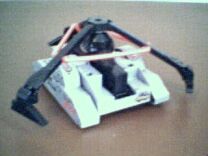
SON OF WHYACHI
As if they hadn't learned their lesson with Blendo, they went ahead and made another spinner-based Custom Series toy in Son of Whyachi.
One of the first things I thought when testing out my new Son of Whyachi toy was, "some toy designer has way too much time on their hands." This toy was created and released when Son of Whyachi still had its rule-exploiting shuffling system instead of wheels. Since the Custom Series chassis is designed with wheels, though, the Son of Whyachi toy needed to use wheels for its locomotion. Now, if I or you were designing the toy, we'd probably say something to the effect of, "Oh well, I guess this Son of Whyachi will have wheels sticking out of it. It's not like the other toys don't have characteristics that aren't the same as the real robots. I mean, look at the size of the saw on Minion, for goodness' sake."
But Tiger went the extra mile for Son of Whyachi. Even though it uses wheels, it still looks like it's kind of waddling around the floor. You see, each wheel is covered by a piece of plastic that we have to pretend represents the shuffling system. The wheels on Son of Whyachi have a little knob positioned in an off-center location on each wheel. The knob fits into a space on the piece of plastic. As the wheel turns, the knob causes the plastic to teeter back and forth. Rather clever, I must admit.
The cage spinner that is Son of Whyachi's distinguishing characteristic has been faithfully reproduced. The cage is made out of a plastic that is more flexible than the plastic used for the other toys' weapons. Obviously, since the arms of the spinner are going to be shoved up against walls and in other unusual positions, you don't want the material to snap in half.
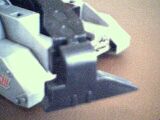
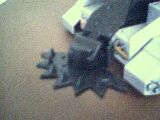 Son of Whyachi's extra pieces are the pointy shapes you place at the ends of the arms of the weapon. In other words, the parts that you or I might consider to be an actual part of the weapon are designed to fall off in a strong impact. If you think that those might look too normal on the toy, you can replace them with ridiculous-looking sun-shaped pieces with lots of useless points sticking out of them. Hey, kids! Leave these pieces on the floor, where your parents can step on them with their bare feet!
Son of Whyachi's extra pieces are the pointy shapes you place at the ends of the arms of the weapon. In other words, the parts that you or I might consider to be an actual part of the weapon are designed to fall off in a strong impact. If you think that those might look too normal on the toy, you can replace them with ridiculous-looking sun-shaped pieces with lots of useless points sticking out of them. Hey, kids! Leave these pieces on the floor, where your parents can step on them with their bare feet!
What is there to say about fighting with Son of Whyachi that I haven't already covered with Blendo... Again, the best strategy is to frequently and faithfully use the "spin around quickly" button to get the weapon turning and then pretend that you're hurting your opponents when you run into them. At least Son of Whyachi has some kind of pushing power with its flat front. I mean, no one says you have to place the cage on the spinning part of the toy.
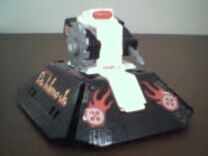
DR. INFERNO JR.
The first thing that you, along with everybody else, think when you see the Dr. Inferno Jr. toy is, "Man alive, somebody's been focusing exclusively on his lower body workout." Yes, this is the problem that you encounter when you model all of the toys around the same chassis -- sometimes proportions are greatly skewed. And now the doctor rides grandly upon his immense pyramid-like base, looking down upon all he views.
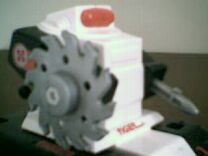 Let's face it -- until the fourth season, Dr. Inferno Jr.'s weapons never ranked very high on the Posing a Threat to Greatly Damage the Opponent scale. And this toy was modeled after the season three Doctor. So its default weapons are a small drill-like thing that pulsates in and out and a saw blade that rotates back and forth (instead of all the way around, like it really matters). About as threatening as DooAll's rod, really. In addition, since the wedged sides are so much taller on the toy, it makes it difficult to even get your opponent high enough to where you can start to say, "My saw is attacking your underbelly! Stop using the left side of your transmitter so I can pretend that I damaged you!"
Let's face it -- until the fourth season, Dr. Inferno Jr.'s weapons never ranked very high on the Posing a Threat to Greatly Damage the Opponent scale. And this toy was modeled after the season three Doctor. So its default weapons are a small drill-like thing that pulsates in and out and a saw blade that rotates back and forth (instead of all the way around, like it really matters). About as threatening as DooAll's rod, really. In addition, since the wedged sides are so much taller on the toy, it makes it difficult to even get your opponent high enough to where you can start to say, "My saw is attacking your underbelly! Stop using the left side of your transmitter so I can pretend that I damaged you!"
 But the makers of this toy went ahead and designed some other weapons that compensate for Dr. Inferno Jr.'s gigantic hips. You can place a piece of plastic over the spike/"drill" thing that extends downward and pokes opponents as it pulsates. The shape of the weapon reminds me of a trident, or maybe a really fancy dinner fork. Regardless, it does nothing to help you during a fight. In fact, it makes things worse by rendering your front wedge useless for scooping up opponents. You can cheerfully put that piece aside, or maybe give it to one of your action figures so they can pretend they're the devil.
But the makers of this toy went ahead and designed some other weapons that compensate for Dr. Inferno Jr.'s gigantic hips. You can place a piece of plastic over the spike/"drill" thing that extends downward and pokes opponents as it pulsates. The shape of the weapon reminds me of a trident, or maybe a really fancy dinner fork. Regardless, it does nothing to help you during a fight. In fact, it makes things worse by rendering your front wedge useless for scooping up opponents. You can cheerfully put that piece aside, or maybe give it to one of your action figures so they can pretend they're the devil.
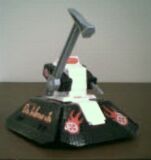 If you don't like the saw, feel free to remove it and replace it with a big honking hammer that repeatedly swings up and down and bonks opponents while they're still on the floor. Obviously, a plastic hammer won't damage your opponent, but that whack-whack-whack noise at least makes things interesting. You can also turn the hammer around so the pointed end is falling on opponents, but the flat end makes a more satisfying whacking sound. Extra credit to the toy designer for including lightening holes in the shaft of the hammer for that added touch of realism, even though the vast majority of Custom Series fights do not require the combatants to be under a specific weight.
If you don't like the saw, feel free to remove it and replace it with a big honking hammer that repeatedly swings up and down and bonks opponents while they're still on the floor. Obviously, a plastic hammer won't damage your opponent, but that whack-whack-whack noise at least makes things interesting. You can also turn the hammer around so the pointed end is falling on opponents, but the flat end makes a more satisfying whacking sound. Extra credit to the toy designer for including lightening holes in the shaft of the hammer for that added touch of realism, even though the vast majority of Custom Series fights do not require the combatants to be under a specific weight.
Special note when fighting Son of Whyachi: The hammer has a nasty tendency to get stuck in the cage spinner. Since it only moves when you drive around, and since you can't drive forward because Son of Whyachi is in front of you and you can't drive backward because the hammer is stuck in the cage, problems may arise.
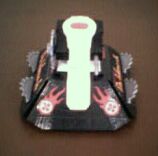 What would make Dr. Inferno Jr. look even goofier than it does now with those gigantic wedged sides? Putting functionless saw blades into those wedged sides! Yes, I'm sure that at every available opportunity, you're going to want to add these saw blade halves to the Dr. Inferno Jr. toy. Why, with those pieces in place, your opponent can't ride up your side wedges, which would theoretically make it possible for you to get underneath and push it around. I can assure you that I have never used these pieces in a fight, for fear that my opponent would look at my toy and start laughing so hard that he or she had to forfeit.
What would make Dr. Inferno Jr. look even goofier than it does now with those gigantic wedged sides? Putting functionless saw blades into those wedged sides! Yes, I'm sure that at every available opportunity, you're going to want to add these saw blade halves to the Dr. Inferno Jr. toy. Why, with those pieces in place, your opponent can't ride up your side wedges, which would theoretically make it possible for you to get underneath and push it around. I can assure you that I have never used these pieces in a fight, for fear that my opponent would look at my toy and start laughing so hard that he or she had to forfeit.
You know, the most effective weapon you could probably give to the Custom Series toys is a wedge, since you can't add any weapon that would actually crack the plastic toys and none of the toys are invertible. And Dr. Inferno Jr. has a wedge. In the front! During a fight, drive that thing full steam ahead into your opponent. If you're lucky (since there is a considerable gap between the wedge and the floor), you'll get underneath your opponent and push it into a wall. Do what I do and yell "WHAM!" or "BANG!" as they hit the wall. It makes it a lot more fun.
It probably won't be long before you start contemplating ways to make the wedge even more effective, disregarding the notion of using the hammer or saw altogether. Maybe that's why these are called Custom Series -- they're just begging to be altered in some way. Pretty soon, you're designing your own antweights... I'm onto your little game, Tiger! Sozbots paid you off, didn't they?
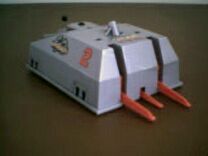
VLAD THE IMPALER
Man, I can't type that anymore without hearing Mark Beiro's voice bounce around my head. Anyway, the Vlaaahhd! The Impaler! toy is the one that I've most recently gotten, so I'm not as familiar with it. But already it's become my favorite Custom Series entry. You'll find out why in a moment (hint: I like lifters).
First, the physical characteristics. Once again, the chassis causes the robot to sport an abnormal growth. For some reason, the lifting forks are bright red. And I haven't the foggiest notion of why there are large number twos on the robot.
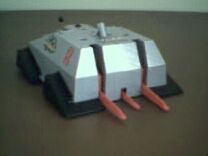 The extra pieces for Vlad are four black wedges that look like they were hastily added to the corners for a lack of ideas of where else one could place pieces to fall off of the toy. Not only are they useless during a fight, but these extra pieces are extremely susceptible to being knocked off. In fact, I can't even pick Vlad up off the floor without one or two of them immediately breaking free. You would probably never place them on the toy for a fight anyway, but at least you don't have to feel guilty about not doing it.
The extra pieces for Vlad are four black wedges that look like they were hastily added to the corners for a lack of ideas of where else one could place pieces to fall off of the toy. Not only are they useless during a fight, but these extra pieces are extremely susceptible to being knocked off. In fact, I can't even pick Vlad up off the floor without one or two of them immediately breaking free. You would probably never place them on the toy for a fight anyway, but at least you don't have to feel guilty about not doing it.
Now let's look at the forks, since they kind of draw your attention, being that bright red and all. We've got one, two... wait a minute, Vlad has mutated and grown a third fork!
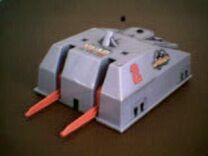 Actually, that's not a fork; it's a spike. As you drive forward, Vlad will suddenly decide to start raising its lifting forks, which are the two outer spikes. The spike in the center remains motionless. Really, it doesn't do anything. At all. For crying out loud, remove it. You'll actually have to take a screwdriver to the toy to make this modification, but I'm sure you can handle it. Hey, I managed to successfully remove the spike, right?
Actually, that's not a fork; it's a spike. As you drive forward, Vlad will suddenly decide to start raising its lifting forks, which are the two outer spikes. The spike in the center remains motionless. Really, it doesn't do anything. At all. For crying out loud, remove it. You'll actually have to take a screwdriver to the toy to make this modification, but I'm sure you can handle it. Hey, I managed to successfully remove the spike, right?
The two forks can move independently a little bit inside the shell, so it's possible that one of them will be raised a little higher than the other during a fight (usually from only getting one fork under an opponent and trying to lift). It's easy enough to remedy once the fight is over (Step one: push the fork down to the level of the lower fork. Step two: Place the toy back on the ground and play with it some more), but is rather inconvenient for the duration of the fight, as it makes it more difficult to cleanly get under your opponent.
Of course, you don't control when Vlad's forks start to move. Your strategy is basically to continually drive into your opponent, keeping those forks underneath the body, and wait for them to start to rise.
But... get this. Are you sitting down? If the forks are in the right position underneath the opponent, they will continue to rise under the opponent's body, pushing it upward. As they push upward, your opponent's wheels will be removed from the floor, making it very easy for you to push your opponent around. And... get ready for this... if your opponent is the right shape, it's possible to flip your opponent over!!! Using the toy! With no modifications! Really!
After a year of just driving toys into one another to see which one will lose its parts first, this is incredibly exciting to me. Finally, a definitive end to a fight! And the feat is hard enough to accomplish that, man, you feel proud when you can get it done.
Not all of the Custom Series toys are as vulnerable to being flipped by Vlad. I've only been attacking motionless opponents so far, but here's what I've discovered: Of my toys, Blendo is the most vulnerable to Vlad's spikes. In fact, it's kind of sad how easy it is to "damage" Blendo when I'm playing as Vlad. As soon as I get the spikes under the shell and start to lift, the shell pops off. Every time. As you can imagine, this puts the Blendo toy at a severe disadvantage. I haven't tried flipping the chassis with Vlad, but I can't imagine it being too terribly difficult.
Son of Whyachi is the next easiest to defeat with Vlad, and the easiest of my toys to flip. If the forks get underneath in the right position under the right area (and if Son of Whyachi's cage isn't getting in the way), some good pushes will put it on its side. From there, you can strand it, or back into it to knock it onto its back and really humiliate it.
Much to my frustration, I simply cannot get a grip underneath DooAll. As I said above, those treads, when motionless, provide very good traction against the floor. Maybe it's possible when DooAll is moving or something.
And believe me, I have tried my dangedest, but I can't get Dr. Inferno Jr. to land on its head. I suspect that the same things that make the real Dr. Inferno Jr. so difficult to flip -- a wide base with a low center of gravity and a toy robot sticking out of the top that pushes against any wall -- make the toy always land on its feet, as well. You're a deceptively complex one, Dr. Inferno Jr.
But still, even though you can only flip some of the other toys, Vlad the Impaler is, hands down, the best of the Custom Series. For example, even if you can't flip it, you can lift the wheels of Dr. Inferno Jr. off the ground. I wish I had gotten this one first.
So there you have it. As a whole, the Custom Series is a mixed bag -- some of the toys are great, some are okay, and some are just plain useless. But if you know (knew) which ones to look out for, you can (could) have a good time with them. And, if nothing else, if you get bored with the way your mass-manufactured toy behaves, you can always turn the chassis into an antweight. I wonder how my Custom Series toys would fare against a real antweight. Any takers? If you're really nice, I might even let your spinner take on Blendo.